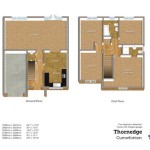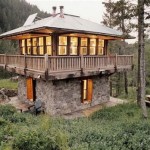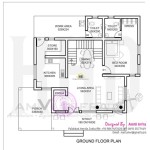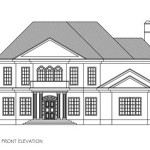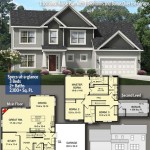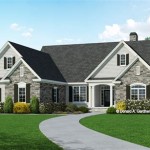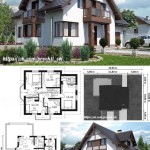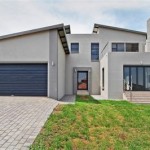House Plan Considerations for a South-East Facing Plot
A house plan designed for a south-east facing plot requires careful consideration of several architectural and Vaastu Shastra principles to optimize natural light, ventilation, and overall energy efficiency. The orientation of a house plot significantly influences the interior environment and the well-being of its occupants. This article provides an overview of key factors involved in designing a house plan that effectively utilizes the advantages and mitigates any potential disadvantages associated with a south-east facing plot.
South-east facing plots receive sunlight predominantly during the morning hours. This can be advantageous, particularly in climates where morning sun is desired for warmth and natural illumination. However, architects and homeowners must also consider how to manage solar heat gain in the afternoon, which can lead to increased cooling costs. Careful planning of room layouts, window placements, and shading devices is essential to create a comfortable and energy-efficient home.
Vaastu Shastra, the traditional Indian system of architecture, offers specific guidelines for designing homes based on orientation. While adherence to Vaastu principles is a personal choice, understanding these guidelines can provide valuable insights into optimizing space usage and promoting positive energy flow within the home. Vaastu emphasizes the importance of aligning the house with the cardinal directions and using specific zones for different activities.
Optimizing Room Placement Based on Orientation
The placement of rooms is a critical aspect of house planning for a south-east facing plot. Considering the path of the sun throughout the day is crucial for maximizing natural light and minimizing unwanted heat gain. Generally, the eastern side of the house is ideal for rooms that benefit from morning sunlight, such as bedrooms, living rooms, and children's play areas. These spaces will be bathed in gentle morning light, creating a warm and inviting atmosphere.
The southern side of the house receives the most intense sunlight, particularly during the afternoon. Therefore, rooms that do not require constant coolness, such as staircases, storage areas, or bathrooms, are typically placed along the southern periphery. This buffer zone helps to shield the interior of the house from excessive heat. Planting trees or shrubs on the south side can also provide additional shade and reduce solar heat gain.
The western side of the house is exposed to the harsh afternoon sun. To mitigate the impact of this direct sunlight, it is advisable to avoid placing bedrooms or living rooms on the west side if possible. If such placement is unavoidable, incorporating shading devices, such as deep overhangs, louvers, or awnings, becomes essential. Alternatively, using thick walls and insulation materials can help to regulate indoor temperatures.
The north side of the house generally receives the least amount of direct sunlight. This area is often suitable for rooms that require consistent light, such as studies or home offices. Kitchens can also be placed on the north side, as they tend to generate their own internal heat. Proper ventilation is crucial in all areas of the house, but particularly in kitchens and bathrooms, to prevent moisture buildup.
Ventilation Strategies for South-East Facing Homes
Effective ventilation is essential for maintaining a comfortable and healthy indoor environment. In a south-east facing plot, natural ventilation can be optimized by strategically placing windows and doors to facilitate cross-breeze. This involves creating openings on opposite sides of the house to allow air to flow freely through the interior spaces.
The size and placement of windows significantly impact ventilation. Larger windows allow for greater airflow, while smaller windows provide more controlled ventilation. Placing windows at different heights can also enhance the stack effect, where warm air rises and escapes through higher windows, drawing cooler air in through lower windows. Operable windows, such as casement or awning windows, allow for better control of airflow than fixed windows.
In addition to natural ventilation, mechanical ventilation systems, such as exhaust fans and whole-house fans, can be used to supplement natural airflow. Exhaust fans are particularly useful in kitchens and bathrooms to remove moisture and odors. Whole-house fans can be used to draw cool air into the house at night and exhaust warm air during the day.
Landscaping can also play a significant role in improving ventilation. Planting trees and shrubs around the house can help to shade the exterior walls and reduce the amount of heat absorbed by the building. Deciduous trees are particularly beneficial, as they provide shade during the summer and allow sunlight to penetrate during the winter.
Vaastu Shastra Principles for South-East Facing Plots
Vaastu Shastra proposes that aligning the house with the cardinal directions and following certain guidelines for room placement can promote positive energy flow and overall well-being. While not a scientifically proven system, many homeowners find value in incorporating Vaastu principles into their house plans.
According to Vaastu, the south-east corner of a plot is associated with the fire element. Therefore, the kitchen is ideally placed in this corner. The entrance to the house should preferably be on the east or north side, as these are considered auspicious directions. The master bedroom is typically placed in the southwest corner, which is associated with stability and grounding.
The central area of the house, known as the Brahmasthan, should be kept open and uncluttered. This area is considered the heart of the house and should be free from any obstructions. The north-east corner is associated with spirituality and knowledge, and is often used for a prayer room or study area. Bathrooms are typically placed in the northwest or south-east corners.
Vaastu also recommends specific colors and materials for different areas of the house. Light and bright colors are generally preferred, as they reflect sunlight and create a sense of spaciousness. Natural materials, such as wood and stone, are also considered auspicious. Incorporating water features, such as fountains or small ponds, in the north-east corner is believed to promote positive energy flow.
It is important to note that Vaastu Shastra is a complex system with numerous interpretations and variations. It is advisable to consult with a qualified Vaastu consultant to obtain personalized guidance based on the specific characteristics of the plot and the individual needs of the homeowners. While incorporating Vaastu principles can be beneficial, it is crucial to balance these considerations with practical design requirements and personal preferences.
In conclusion, designing a house plan for a south-east facing plot requires a holistic approach that considers orientation, ventilation, and Vaastu Shastra principles. By carefully planning room layouts, window placements, and shading devices, homeowners can create a comfortable, energy-efficient, and harmonious living environment.

Pin On Wood Chair Diy

South Facing Plot 30 X 40 Feet I East House Plan 27 35 9 2bhk Plans Small Floor

South East Facing House 2 Bhk Plan Drawing Dwg File Cadbull

South Road East Face House Plan 30x60 Main Gate Door 3 Bed Room West Facing Plans

South East Corner Plot House Plans Plan And Designs Books

36x40 South Facing House Plan According To Vastu And Designs Books

30x33 South East House Plan With Car Parking Face Home Vastu

South Facing Home Vastu Plan

North Face House 2bhk Plan 20x40 Plans N

House 30 X30 South Facing S3 Rsdc

